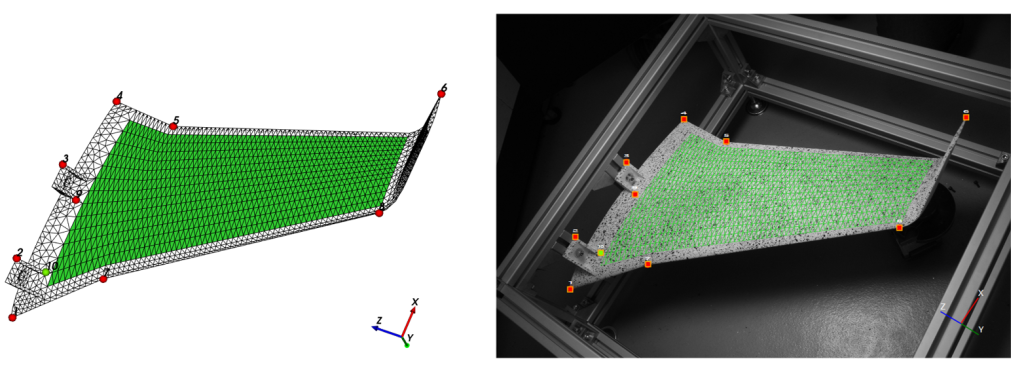Preparation of your Digital Image Correlation test with Blender
- By Clara Minguet, Research engineer at EikoSim
This article invites you to care about an unexpected topic: the preparation of a digital image correlation test with Blender. While research articles do not always mention this aspect of digital image correlation measurements, test preparation is a crucial step in the procedure. The aim is to ensure that the images that will be taken by cameras will be usable with an image correlation software before the test. In other words, it is necessary to make sure that these images will lead to a correct calibration of the cameras and therefore to a displacements computation as accurate and precise as possible. To guarantee the convergence of the calibration algorithm and the quality of the calibration, the user has to carry out a good initialization of the cameras parameters. In EikoTwin DIC software, this is done by selecting pre-calibration points. This procedure must respect 3 conditions:
- A good distribution of points in the 2D space of the image,
- A good distribution of points in the 3D space around the average plane,
- A sufficient number of points (10 minimum).

The respect of these 3 conditions depends only on the instrumentation and the test conditions. As a priority, the region of interest of the part must be speckled and visible throughout the test by the camera in a monovision case, and by at least 2 cameras in a stereovision case. It is also necessary to pay attention to the optimization of:
- The camera positions in relation to each other and relative to the part and its environment,
- The speckle pattern that must be adapted to the intended application,
- The lighting that must be homogeneous in time and space,
- The environment, using a calibration target if necessary.
In addition, all these parameters are constrained by the environment in which the digital image correlation test takes place. It can be particularly congested with at least one testing machine, cameras, lighting, and associated tripods. It can therefore be complex, when instrumenting a digital image correlation test, to optimize the calibration while adapting to the test environment, mainly in an industrial environment. In this type of situation, it would be very advantageous to be able to anticipate the appropriate position of the cameras in order to ensure a good measurement. This would avoid having to repeat the tests in case of unusable images. It would also prevent the test machine from being unavailable for a long period of time when setting up the instrumentation.
Solution: Preparation prior to the test by generating virtual images with Blender software
The solution to this issue is the achievement of a preliminary study before the test instrumented by digital image correlation with the Blender software . This prior step will ensure the feasibility of the test and the determination of the most suitable conditions for its smooth progress.
Blender is an open-source 3D-modeling and rendering software that has been developed from 1998. Even though it is open-source, it largely competes with very well known commercial softwares in its field of expertise. Its main use lies in the creation of animation movies and aesthetic 3D-rendering. However, it can also be used for mechanical testing because its render engine can produce physics-based photo-realistic renders.

Figure 2 – Aesthetic 3D-rendering on the right created in Blender from the scene on the left.
Blender allows the integration of a test environment and a finite element model in the same scene. In addition, it allows the integration of cameras to simulate the digital image correlation system. Based on these two features, it will therefore be possible with Blender to model a test environment scene in which the user can choose the position of the cameras. He will then be able to generate images of the initial and deformed states of his mechanical test. For this purpose, EikoSim has co-developed codes in Python language with the company Sciviz to deform node by node the mesh of the part in Blender, from the results provided by a simulation software, and to save at each loading step the field of view of the cameras in the scene. These “virtual” images can then be processed with an image correlation software. The user will thus access an estimate in advance of the software performance that he can expect for this test, in these conditions as realistic as possible. Finally, Blender makes it possible to create virtual tests as close as possible to real tests in order to prepare them optimally.

Examples of concrete cases
To demonstrate in a more concrete way the interest of carrying out preliminary studies with Blender, I suggest you watch the video available below from 8:18. The issues encountered during 3 real tests for which a preliminary study proved to be essential are presented.
To go further in the preparation of a test with Blender…
The usefulness of the Blender software in the preparation of tests instrumented by digital image correlation is undeniable. However, handling the software and the associated codes remains tedious. This is why we have created a new tool from the EikoTwin suite, EikoTwin Virtual, as an add-on module directly integrated into Blender . This tool was created in collaboration with Matthieu Vitse, PhD in structural and material mechanics, from the company SciViz . It makes performing virtual tests on Blender faster and more intuitive.
If you have any questions thereon or about this article, you can contact us via the contact interface on our website. Also, if you are interested in using Blender software for your digital image correlation tests, we provide trainings on how to use the software applied to digital image correlation in which we also introduce EikoTwin Virtual.



